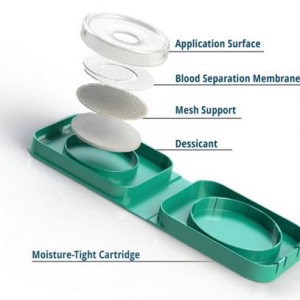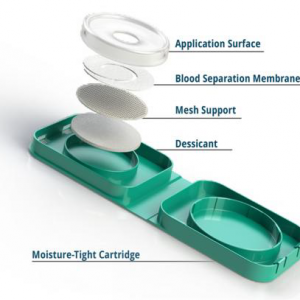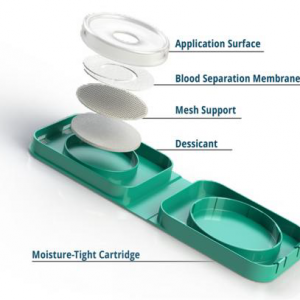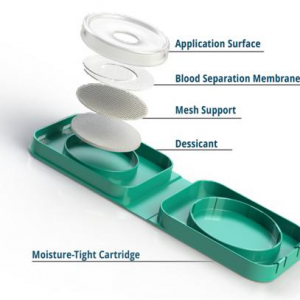Description
![]()
StatShell Information
Collection Instructions
Sample Lab Report
Unit: 1 Each
Contents: 1 Collection Kit (Instructions, Blood Collection Card, Lab Form, Blood Sample Return Bag, Prepaid Return Envelope, Wound Kit, Lab Processing, Results Reporting)
Determinations: High sensitivity C-reactive Protein (hs-CRP) & Glycated Hemoglobin (HbA1c)
Storage Requirements: 59° – 86° FThe hs-CRP / A1c Combo Collection Kit is an effective method of determining a patient’s risk for heart disease as well as diabetes. Only a single finger stick is required to obtain a sample. In one week, a comprehensive report containing quantitative results will be issued, permitting physicians to make a prompt diagnosis and begin treatment.C – reactive protein (CRP) serves an important function in innate immunity as an early defense system against infection. CRP is produced by the liver in response to a wide range of acute and chronic inflammatory conditions. It binds to phosphocholine found on the surface of dead or dying cells to enhance phagocytosis and to aid in the clearance of necrotic and apoptotic cells. Though it is not condition-specific, an elevated CRP level is a significant indicator of health complications which necessitate medical attention.Several factors can cause an increase in CRP including infection, tissue trauma, malignancies, inflammatory diseases (various types of arthritis), autoimmune diseases, and arterial inflammation and damage (symptoms of cardiovascular disease). CRP , specifically high sensitivity C-reactive protein (hs-CRP), is considered an important indicator of heart disease by the American Heart Association. Patients with high CRP concentrations are found to have increased risk of myocardial infarction, stroke, and severe peripheral vascular disease.Healthy men and women with normal cholesterol levels can still be at risk for heart attack if they have elevated levels of hs-CRP. The hs-CRP test is an important tool for assessment of overall cardiac health. Testing is recommended for patients with high risk factors for cardiovascular disease.Risk factors for heart disease:
- Obesity
- Smoking
- High blood pressure
- Uncontrolled diabetes
- Previous heart attack or stroke
- Family history of cardiovascular disease
- Elevated Total Cholesterol and LDL levels
- Low HDL levels
- Post-menopausal women
The hs-CRP Test provides the same results that can be obtained from your local medical laboratory without the high cost and inconvenience of doctor’s appointments, laboratory fees, and the often painful and unnecessary procedure of direct venous or arterial blood draw. This test can be conveniently performed at home in less than ten minutes, and quantitative results can be obtained in approximately the same time as those routinely ordered through a physician. It is recommended that a patient wait at least 2 weeks after an acute or chronic inflammatory event (such as a cold, infection, or tissue trauma) to measure hs-CRP.High-Sensitivity C-reactive Protein (hs-CRP) Levels
Low Risk – Less than 1.0 mg/L
Moderate Risk – 1.0 to 3.0 mg/L
High Risk – More than 3.0 mg/LNote: Women using Intrauterine devices (IUD), those who are pregnant, and post-menopausal women on hormone replacement therapy will usually have a higher-than-normal CRP level.The A1c (glycated hemoglobin or HbA1c) test reveals a snapshot of average blood glucose control for the past 2 to 3 months. These results can indicate how well a diabetes treatment plan is working or serve as a warning sign for a pre-diabetic condition.Most Common Symptoms of Diabetes:
- Frequent urination
- Disproportionate thirst
- Intense hunger
- Weight gain
- Unusual weight loss
- Increased fatigue
- Irritability
- Blurred vision
- Slow healing or improperly healing wounds
- Increased skin and/or yeast infections
- Itchy skin
- Red, swollen, or receding gums
- Male sexual dysfunction
- Numbness or tingling in hands and feet
Non-diabetic patients fall within a normal A1c range of between 4.5 to 6 percent, whereas a range of 5.7 to 6.4 percent is a strong indicator for prediabetes. A patient that has already been diagnosed as diabetic customarily maintains an A1c level of 7 percent or less, while readings of 8 percent or higher indicate poor blood sugar management. Diabetic patients are advised to maintain daily blood glucose levels at or near the normal range of 70 mg/dl to 120 mg/dl before meals and under 140 mg/dl at 2 hours after meals. If the patient’s A1c level is above the target range, it is important that they consult with their physician about modifying their treatment plan.Diabetes usually takes its toll slowly, gradually attacking the eyes, organs, and extremities. Continuous control is imperative. The Diabetes Control and Complication Trial (DCCT) has shown that the lower the A1c number, the better the patient’s chances of slowing or even preventing serious damage to the eyes, nerves, and kidneys. Any improvement in these numbers has the potential for reducing complications.The American Diabetes Association (ADA) recommends the A1c test as the best method for determining a patient’s blood sugar control over an extended period of time. The ADA further recommends that patients test their A1c levels every 3 months if they are taking insulin, making changes to treatment, or during periods of high recorded blood sugar levels. Patients taking oral medications and those with stable blood sugar levels should take the test every 6 months.Complete instructions are included, and sample collection is quite easy and virtually painless. A single finger stick using the enclosed lancet is all that is required to obtain the sample needed. Simply deposit the drops of blood on the collection card and wait 30 minutes for it to dry. Then place the card in the enclosed postage paid return envelope along with your completed Laboratory Authorization Form, and drop in the nearest US mailbox.After your sample has been analyzed at the Laboratory, you will receive a report by mail that will provide you with important information you and your physician can use to access your diabetes control. Maintaining health blood sugar levels is one of the most important steps you can take in preventing or decreasing damage caused from diabetes.Expect to receive your quantitative test results within one week from the time your test has been received by the Laboratory.hs-CRP & A1c Collection Kit (Mail-In) Includes:Instructions
Blood Collection Card
Lab Form
Blood Sample Return Bag
Prepaid Return Envelope
Wound Kit
Lab Processing
Results ReportingWound Kit contains: (2) Lancets, Alcohol Prep Pad, Gauze and Band-aid




